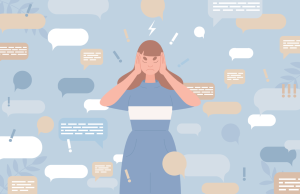
Many of us are familiar with how disruptive noisy workplaces can be. Excess noise can make it difficult to focus on and complete tasks, hear one another, and in some cases, can even affect mental and physical health. Excess sound, or a lack of sound privacy, can also be a major drain on employee morale. Crucially, employees with disabilities can be affected by noisy work environments far more than those without. Noise can be particularly problematic for deaf or hard-of-hearing (HH) people, people with blindness or low vision, those with conditions like Attention Deficit Disorder (ADD) and Attention Deficit Hyperactivity Disorder (ADHD), and people with Autism Spectrum Disorder (ASD). Here, we’ll go into further detail on how noise can be disruptive for these disabilities, and how to address these issues in the workplace.
A previous tip sheet and post on deafness/HH mentioned that many deaf/HH people actually do have some level of hearing, but the sounds they hear can seem very quiet or muffled. As such, excess noise can be a great interference, as it makes important sounds harder to hear or understand, or unable to be heard or understood at all. Additionally, those who use hearing aids might be especially affected as they may amplify all sounds, so even small or background noises can easily become overwhelming. All of this can cause the deaf/HH person to put in a lot more work into listening, causing listening fatigue. People with blindness/low vision can also be greatly impacted by noise. Studies have shown that blind/low vision people are more sensitive to audial stimuli, so sounds that may seem quiet or easy to ignore to sighted people may come across much louder or otherwise be hard to filter out. Additionally, as we’ve touched on in past tip sheets and posts, many blind/low vision people rely on audial cues – from equipment, coworkers, screen readers, etc. – and excess noise can interfere with their ability to hear these cues properly. Similarly, hypersensitivity to sound is a common symptom for those with ADD/ADHD or ASD. For some, it may be severe enough that loud or excess noise may cause physical sensations or distress. For others, it may simply be that they are unable to filter out background and competing noises, therefore making it extremely difficult, if not impossible, to focus on a task at hand.
Solutions will vary by case, but there are many options to reducing disruptive noise in the workplace. If circumstances allow, one of the simplest options is to permit the use of noise-cancelling headphones or earplugs, or to allow the employee to listen to sounds that they find helpful, such as white noise, nature sounds, or music. When it comes to the work environment itself, there are many possibilities. First is to try to buy the quietest version of a given piece of equipment available, and to keep up with maintenance of equipment – lubrication, cleaning, etc. – to prevent it from making excess noise. Turning off unnecessary sounds, such as computer speakers, notification or clicking sounds on phones, etc., or muting certain pieces of technology can also make a big difference. Try to have important meetings in quiet rooms. There can also be dedicated quiet and loud spaces. Finally, if your workplace requires the presence of loud equipment, try to reduce noise by isolating that equipment, or installing soundproofing measures. It can make a significant difference.
Additional Resources
- More detail on how noise can affect health can be found in this study on noise in the workplace.
- Reducing Background Noise in the Classroom and Optimizing Your Acoustic Environment is, as the title implies, about educational environments, but the tips therein can be used in the workplace and in meeting rooms too.
- How Noise Affects Individuals with Autism may offer a better understanding of how noise can be difficult for people with ASD.




 See More Feature Articles
See More Feature Articles